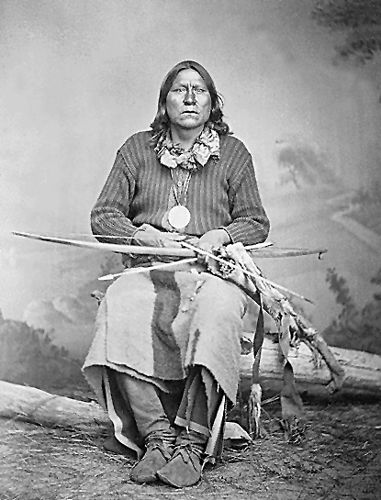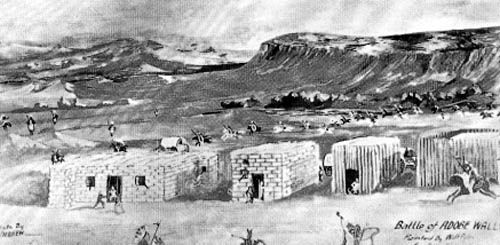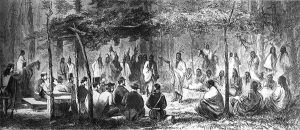Known to his people as Set-Tainte, meaning “White Bear Person,” Satanta was a great Kiowa warrior who later became the principal chief in the Kiowa Wars of the 1860s-1870s and was known as “The Orator of the Plains.”
He was born about 1820, during the height of the power of the Plains Tribes, probably along the Canadian River in the traditional winter campgrounds of his people.
After developing a reputation as an outstanding warrior, he was made a sub-chief of his tribe under Chief Dohasan while still in his twenties. In appearance, he was described as tall, having a fine physique, erect bearing, and a piercing glance.
He fought with Chief Dohasan at the First Battle of Adobe Walls in 1864 and earned enduring fame for using an army bugle to confuse the troops in battle.
His speaking abilities gained him the title of “Orator of the Plains.” As such, he negotiated several treaties with the American government, including the Little Arkansas Treaty in 1865 and the Medicine Lodge Treaty in 1867, which required the Kiowa to be placed on a reservation.
The treaty assured the Kiowa people rule over the lands set aside for them, but white settlers continued to pour across their territory. As a result, the Kiowa continued to raid settlements and harass immigrants.
The unstable situation got worse when Chief Dohasan died in 1866. Without his strong leadership, competition between several sub-chiefs, including Satanta, Guipago, and Tene-angopte, resulted in more raids across the southern plains from Kansas to Texas, during the fall of 1866 and into 1867. During one of these raids in the Texas Panhandle, the Kiowa killed a man named James Box and captured his wife and four children, whom they sold to the army at Fort Dodge, Kansas.
By this time, Satanta’s fame as a warrior and a leader was growing, but he could not defuse a confrontation between the Kiowa and the U.S. Cavalry near Fort Zarah, Kansas, in 1867. After a young Kiowa warrior was killed at the civilian camp near the army fort, the Kiowa gathered to avenge his death. The cavalry retaliated by attacking the Kiowa encampment, in which several children were killed during the brief skirmish.
The Medicine Lodge Treaty of 1867 failed to resolve the sources of conflict, and by early 1868 the Kiowa and other plains tribes were actively attacking white settlers.
Fearing that these attacks led to an Indian uprising, General Philip H. Sheridan was sent in to restore order in the “winter campaign” of 1868-69. Sheridan’s strategy of destroying Kiowa homes and horses dampened the Kiowa’s will to resist, especially after Lieutenant Colonel George A. Custer destroyed the southern Cheyenne village on the Washita River on November 27, 1868.
Upon hearing of Custer’s willingness to kill women and children, Satanta and Guipago surrendered. Flying a flag of truce, the two chiefs approached Custer on December 17 but were immediately arrested and held for nearly three months while Custer sought permission to hang them. Finally, in February 1869, Tene-angopte negotiated their freedom by promising that the Kiowa would return to the reservation and cease all attacks on white settlers.
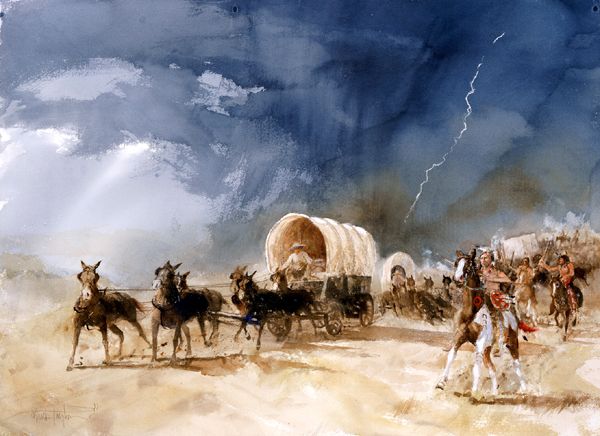
Warren Wagon Train Raid by Buck Taylor.
However, by 1871, Satanta and his followers were not satisfied with the reservation and began to make several attacks on wagon trains in Texas. On May 18, 1871, Satanta, Big Tree, and Satank led an attack on the Warren Wagon Train Raid in Texas. Also known as “The Salt Creek Massacre,” the incident occurred as Henry Warren was contracted to haul supplies to Texas forts, including Fort Richardson, Fort Griffin, and Fort Concho. While the freight train was traveling down the Jacksboro-Belknap Road on May 18 towards Salt Creek Crossing, they encountered General William T. Sherman, who had allowed the Satanta and his men to pass unmolested. Less than an hour later, the wagon train spotted a group of about 100 warriors.
Recognizing an imminent attack, the wagon train quickly pulled into a ring formation, but the 12 teamsters were overwhelmed by the warriors. When the attack was over, the Indians captured the supplies and killed and mutilated seven of the wagoneers. Five men managed to escape, and Thomas Brazeale reached Fort Richardson on foot, some 20 miles away. When Colonel Ranald S. Mackenzie learned of the attack, he immediately informed General Sherman, who dispatched Mackenzie to bring the offending Indians to justice.
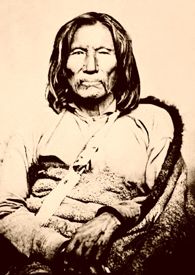
Kiowa warrior Setangya, aka: Satank, Sitting Bear, by William S. Soule
Their mission, however, proved unnecessary as Satanta, shortly after returning from the raid with his men to Fort Sill, Oklahoma, to claim their rations, was questioned by Indian agent Lawrie Tatum. The warrior, obviously using bad judgment, responded by boasting about the raid, and a horrified Tatum quickly turned the chiefs over to General Sherman. The warriors were then sent to Jacksboro, Texas, to stand trial for murder. Bound hand and foot, Satanta, Satank, and Big Tree left Fort Sill on June 8, 1871. Satank was later killed while resisting a guard, and Satanta was warned that he might be hanged for his crimes. Satanta responded: “I am a great chief among my people. If you kill me, it will be like a spark on the prairie. It will make a big fire – a terrible fire!”
Satanta and Big Tree were tried in Texas and sentenced to death, but Texas Governor Edmund Davis, overruled the court, and the punishment was changed to life imprisonment. While in prison, a visitor described him as “a tall, finely formed man, princely in carriage, on whom even the prison garb seemed elegant.” Just two years later, Satanta was released in 1873, conditional upon the good behavior of their people.
The following year, Satanta and his warriors were back on the warpath, attacking buffalo hunters and engaging in what is known as the Second Battle of Adobe Walls, which occurred on June 27, 1874.
In October 1874, Satanta was captured and again placed in the Texas Penitentiary at Huntsville. Unwilling to spend the rest of his life in prison, Satanta committed suicide on October 11, 1878, by throwing himself from a high window of the prison hospital.
Big Tree, with other chiefs believed to be secretly hostile, were confined as prisoners at Fort Sill, Oklahoma. After Big Tree’s release, he lived on an allotment from the reservation until he died in 1929.
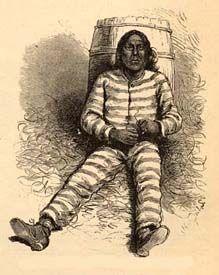
Satanta in prison
© Kathy Alexander/Legends of America, updated March 2023.
Also See:
Kiowa – Nomadic Warriors of the Plains
Adobe Walls – Buffalo and Battles
Medicine Lodge Peace Treaty Site
Fort Sill – Last Active Frontier Fort

